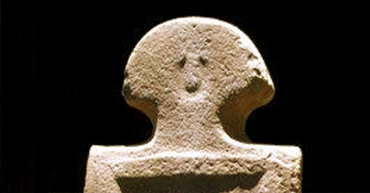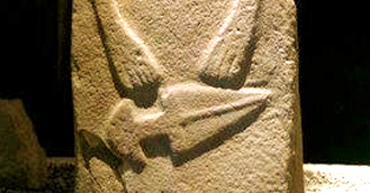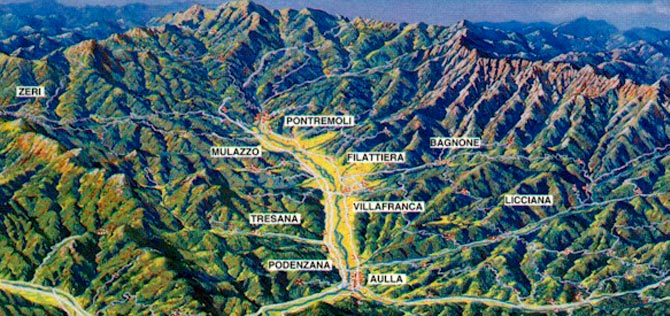Lunigiana
History
Lunigiana, a subtle mix of the regions of Tuscany and Liguria, takes its name from the ancient sea port of Luni, a Roman colony since the 2nd Century CE, situated on the mouth of the River Magra. The Romans conquered the area from the ancient Ligurian-Apuan tribes, whose memory can still be admired today in the Stelae Statues, the mysterious anthropomorphic figures uncovered in 1827 in the ancient town of Zignago and now on display in the Museum of Pontremoli. Subsequently, in the 5th Century came the Vandals and after them the Longobards. At the end of the first millennium the Malaspina family contended with the Counts of Luni for control of the territory and were successful in their endeavour. In 1802, after subsequent fragmentations, Lunigiana became part of the newly developing, Italian Republic. In 1815 the ancient region was divided between the Kingdom of Sardinia and the Duchies of Modena and Parma, finally reaching the present day division between Tuscany and Liguria.
Medieval Castles and Towns
History bears testimony to the natural beauty of the area, which is situated a short distance from the sea but surrounded by the splendid, mountainous landscape of Tuscany and Emilia from north-west to south-east, and the Apuan Alps from the south to the coast. In Medieval times the Longobards built churches in the area as well as chapels, towns and about 160 castles, coinciding with the construction of the ancient Via Francigena road. The road was built from the need to connect the Kingdom of Pavia in the north and the southern duchies in a suitably safe way, and the castles formed a network of forts of economic and cultural strategic importance. Armies, travelers and pilgrims would use this route, as well as religious worshippers on their way to Rome, Santiago de Compostela and Jerusalem. The typical tales and legends linked to castles have survived to the present day in Lunigiana; stories of intrigue, torture, ghosts and mystery. Fosdinovo Castle and the small, ancient Medieval town of the same name, is still inhabited by Malaspina descendants to this day; Malgrate Castle in Villafranca, another important fief belonging to the Malaspina family; Piagnaro in Pontremoli where the famous Stelae Statues are displayed; Verrucola Castle; the Castle of Castiglione del Terziere where there is a library of texts and archives on the history and literature of Lunigiana; Treschietto Castle; Malaspina Castle, Carrara, which houses the head offices of the Academy of Fine Arts; Castevoli Castle; Malaspina Castle in Lusuolo with the Tuscan Emigration Museum: Malaspina Castle, Massa, one of the largest fortified castles in Tuscany; Brunella Fortress, which is surrounded by botanical gardens of great interest and houses the Lunigiana Natural History Museum. Other castles in the area include: Villa Tresana Castle, Aghinolfin Castle, Bastia Castle, Comano Castle, Gragnola Castle, Monti Castle, Podenzana Castle, Tresana Castle, Malaspina Castle in Terrarossa, Malnido Castello in Villafranca. The characteristic Medieval towns are particularly interesting to visit: Ponticello, with its narrow streets, stone houses and ancient Medieval tower-houses, called 'le Caminate'; the walled town of Caprigliola with its unusual architecture; Filetto, a medieval, rectangular shaped town, famous for its antique markets; Filattiera with the Romanesque parish Church of Sorano; Mulazzo, first capital of a Malaspina fiefdom; Succisa, famous for its PGI quality porcini mushrooms and PDO honey and Montereggio, the village of booksellers, which organizes many events centred on books.

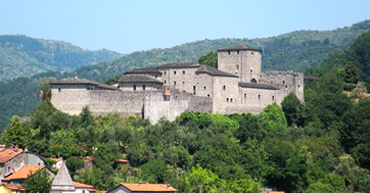
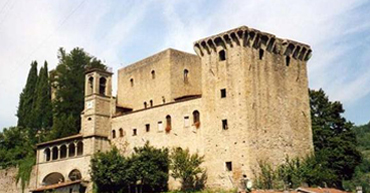
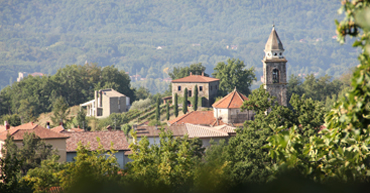
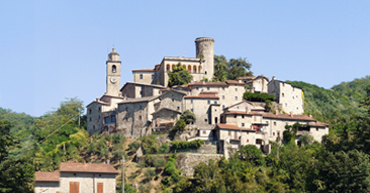

The Stelae Statues
The famous Stelae Statues are displayed in the old museum inside Piagnaro Castle, Pontremoli. They are the oldest in Italy and part of Lunigiana's very own ancient and mysterious heritage. Probably dating back to between 3000 and 600 BCE, these figures represent warriors brandishing knives and women with stylized features wearing ornaments. The significance of these statues made from local sandstone is still unknown to this day. Perhaps the figures represent the gods, goddesses and heroes of the ancient Ligurian-Apuan and Etruscan tribes living in Lunigiana in pre-Roman, prehistoric times and are still shrouded in mystery. The typically crescent-shaped head common to all the Stelae has become the symbol of the entire Lunigiana area.
